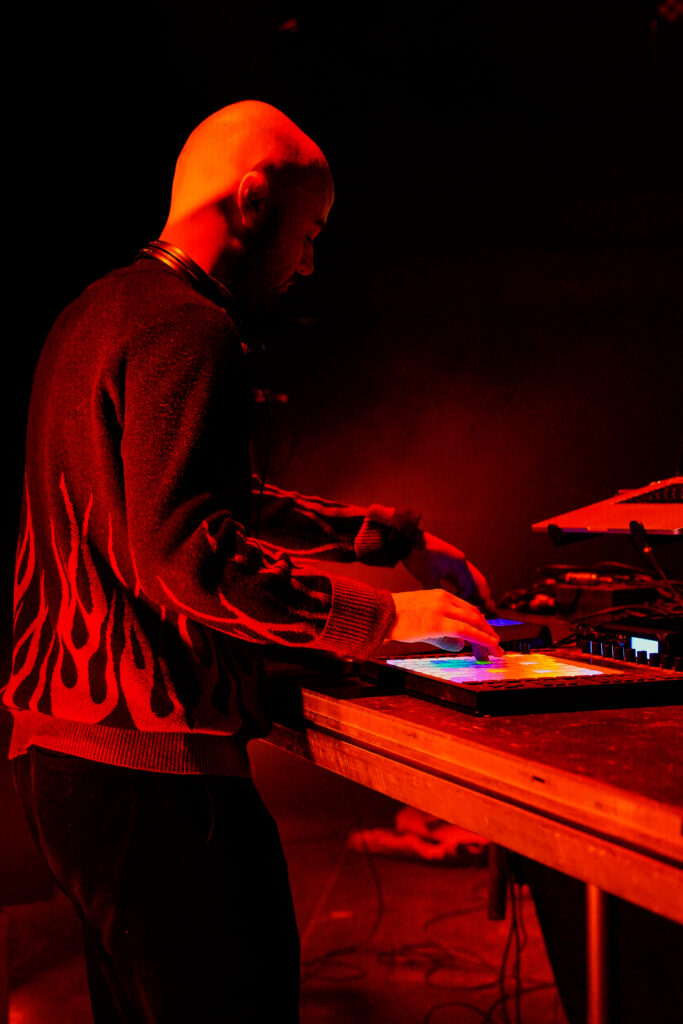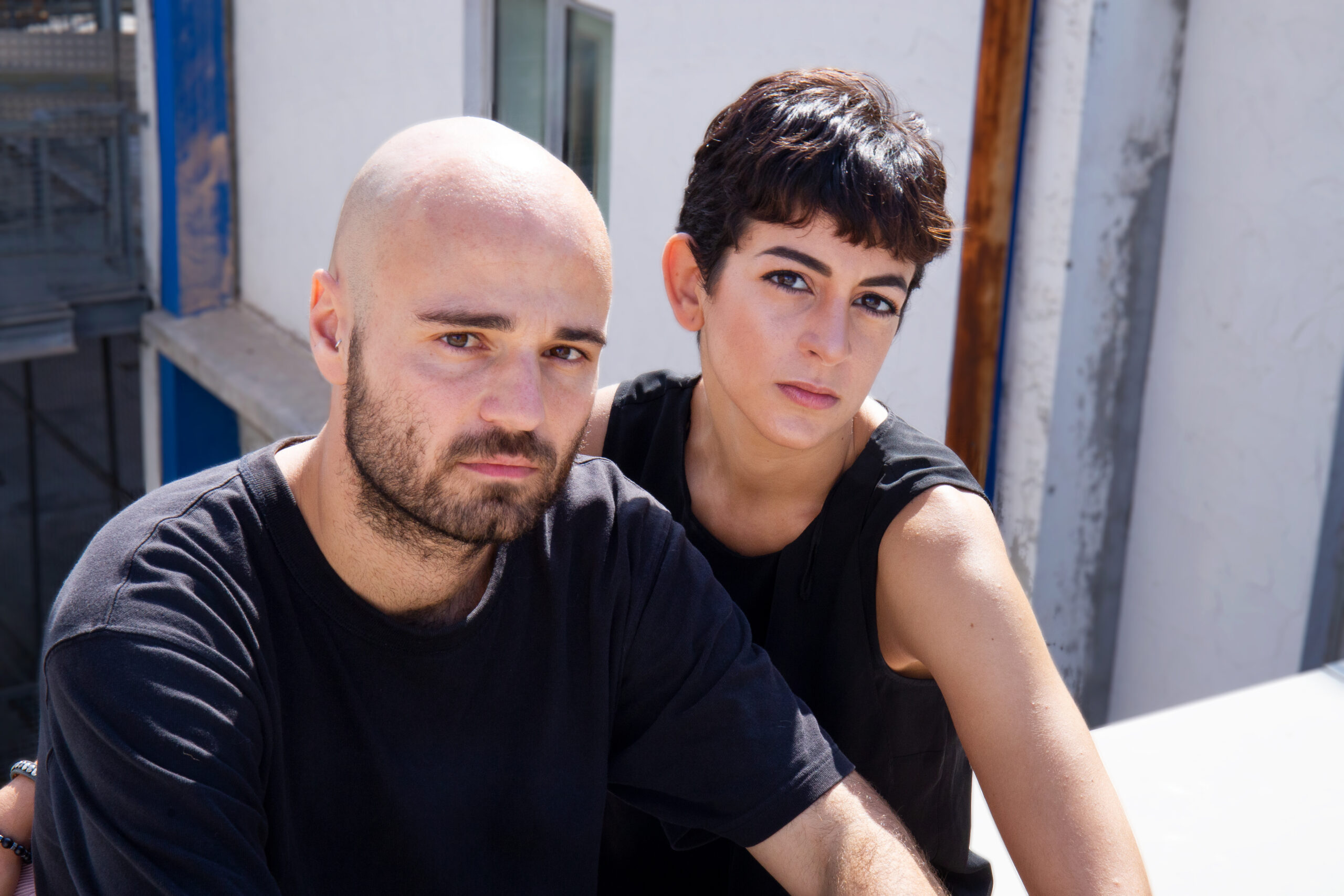Tim Karbon for Couvre x Chefs
New spotlighted signature of the Bi:pole agency, recently seen during many French live shows and festivals such as the 2022 edition of Saint-Étienne’s Positive Education or Marseille’s META party nights, Vanda Forte and Sinclair Ringenbach make music under the double alias of Cainو Muchi. With this project, they mix influences ranging from rap to bass music via ambient, with poetic reflections and an invigorating connection with the innumerable sound traditions from Arab and North African territories. Both dark, delicate, and danceable, the duo’s music tears up codes and preconceptions about an electronic culture that has sometimes become too rigid or obtuse. And this opens the field of possibilities towards an artistic future where the requirement of refined sonic textures and the fragile energy of our moving bodies become the armrests of an explosive musical transidentity.
Following their release party in the Montreuil-based venue of La Marbrerie last January 18, we exchanged the time of a video call, in order to more deeply detail the contours of this dense and mesmerizing project.
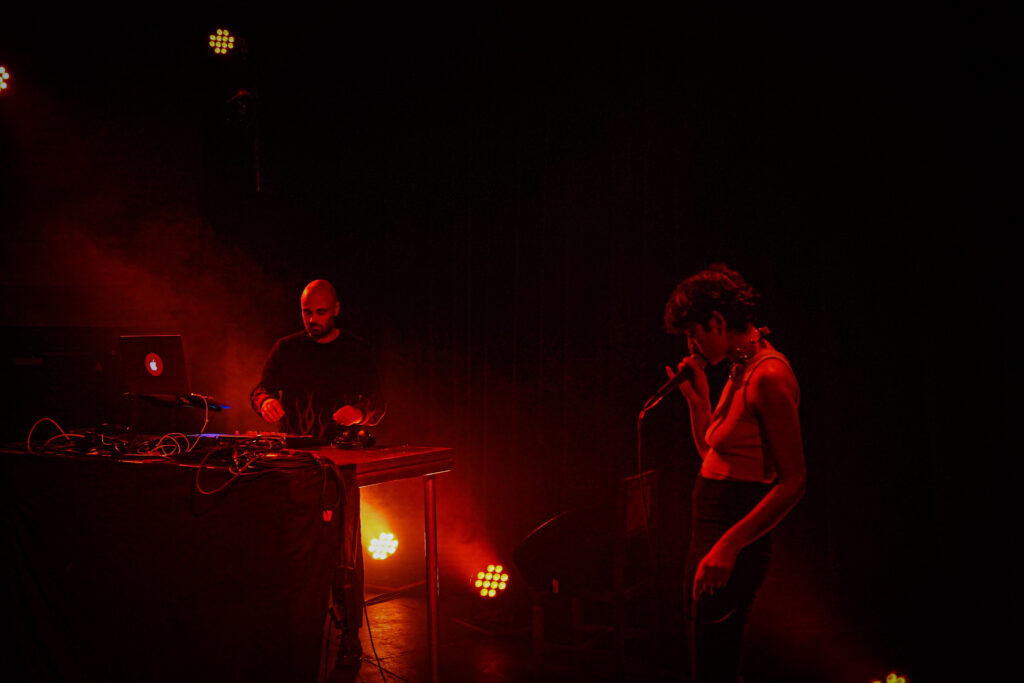
Hello Vanda and Sinclair, I am delighted to be able to start this discussion around the release of your new EP Warda و ر د ة which has just been released this Friday, February 3, 2023. Having had the pleasure to meet you both at your release party at La Marbrerie of Montreuil, near Paris, a few weeks ago, I would, first of all, have wanted to know your feelings about this show. How did you both experience this live moment? And how did you approach it compared to the previous one, when you played at the Positive Education Festival in Saint-Étienne in November 2022, which took place on a much larger and therefore less intimate stage?
Sinclair: Hello! We are also very happy to discuss our joint project with you. Regarding our recent live at La Marbrerie, we quickly noticed the large width of the stage for a medium-sized venue, because until then we had not had the opportunity to play in such a large space, which allowed us to have all the necessary comfort to arrange our setup. I was thus able to place myself on one side of the stage, to give Vanda all the space he needed to move around the rest of the floor.
Vanda: Hello and thank you for giving us this opportunity to exchange! To add to what Sinclair just said, it was really great for me to have all this stage space to express myself physically, which wasn’t necessarily the case during Positive Education, which is nevertheless a festival stage. To come back to your question, it was a concert that we therefore almost surprisingly considered in a more intimate way. As I systematically immerse myself in the place to adapt my stage performance, La Marbrerie has this quasi-industrial “punk” cachet that we really liked from the start, which filled me with great energy to perform.
Sinclair: And also, you had the idea of getting on stage under the skirt of the floor, from below, which is kind of unusual. In general, we often try to improvise our live entries. Even if for my part, I am still a little constrained by the space taken up by my machines, Vanda is thus hands-free to imagine new forms of spatial expression.
Vanda: However, we are always in the process of developing together new ways of thinking about live scenography, without being so unilaterally arranged. Thinking about configurations in which Sinclair would be more expressive on stage.
Sinclair: Yes, and thus avoid the conventional comparisons with the “rapper + beatmaker” format, which is a pitfall that we seek to avoid in the long term. The release party at La Marbrerie was our second live show with this new formula. We are very happy to have felt people really caught up and focused by the whole performance, even despite this stage separation still being a bit conventional to our taste.
Vanda: Exactly, and as far as I’m concerned, it’s essential to feel this strong link, this communicative energy with the audience, which is as much due to the configuration of the room as to the way in which we gradually develop the intensity of this moment live. At the start, we were evolving in a format in which we were both behind machines, in the extension of our collective production work in the studio, and therefore with very little vocal intervention. Now that my voice has taken more space, we can again imagine a scenic layout where we will include more instruments played live.
Sinclair: We are thinking in particular about experimenting with live moments with organic percussion, played by Vanda or me (or both simultaneously).
Vanda: Yes, and have the possibility of including, as in most of our productions, instruments from the MENA region (editor note: Middle-East / North Africa) such as Bendir (percussion of Amazigh origin used particularly in Chaabi), the Derbuka or the Gaita (instrument with a tone range close to the oboe, including many variations within traditional Mediterranean music). I grew up and learned to sing in contact with these instruments, so it seems legitimate to me to propose a renewed approach within the framework of our lives.
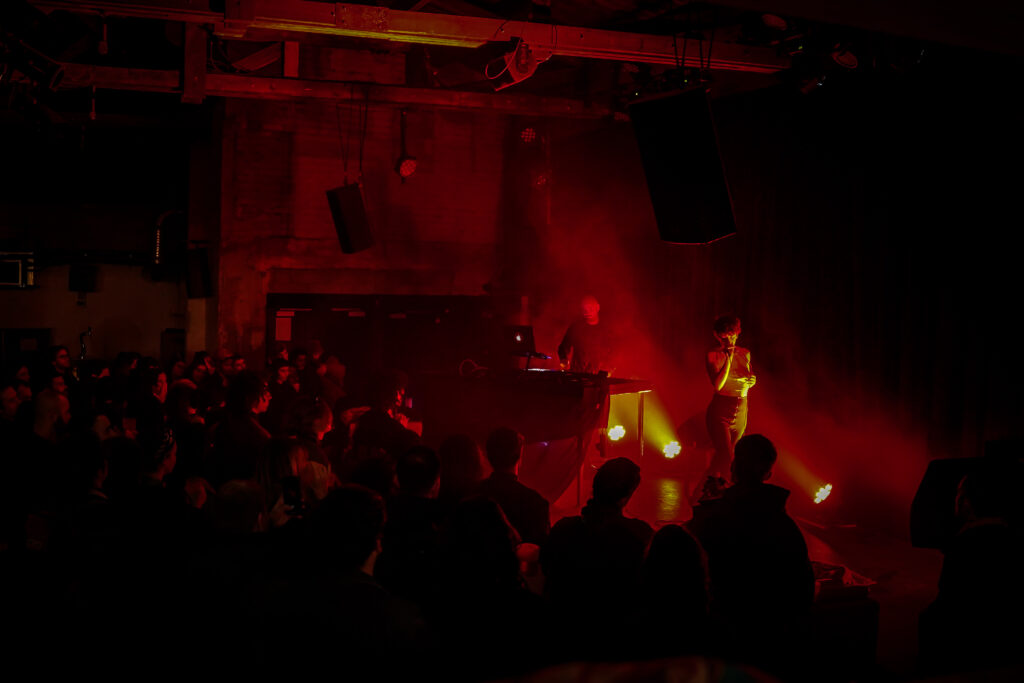
Most of your track titles as well as the name of your duo Caïn و Muchi are written in two alphabets (Arabic and Latin). Could you tell us more about the meaning of the latter as well as the use of this double language?
Vanda: Regarding the titles of our pieces, we have chosen together to carry out a semantic translation of these in Latin and Arabic, for all of them. And sometimes, this transcription is accompanied by another translation, phonetically speaking, as with the track “Hustler حصلة” which can also be heard as “hassle” and means “problems” in Arabic.
Sinclair: As for the name of our duo, I had originally thought of launching my new solo project under the alias Caïn in reference to this biblical character considered to be the first murderer in history, as told in Genesis, who killed his brother Abel…
Vanda: …and I joined! (laughs)
Sinclair: Yeah that’s it (laughs), anyway I wanted to have a darker artist name to also cut with a more playful aesthetic that was specific to my older productions. And I also guessed that the pronunciation of the word “Caïn” resonated well with my ear, and had a certain enigmatic quality beyond the obvious biblical reference.
Vanda: Personally, I’ve started to share my opinion and some feedback on the songs that Sinclair sent me under this new alias during the first lockdown of 2020. In the beginning, it was mostly driven by my intention to give him friendly advice and attentive listening to his work, but this quickly turned into a desire to collaborate in the development of this music. Then I started to try to put my voice into his productions and, step by step, to send him samples of oriental sounds or ideas of arrangements, which resulted in the first drafts of our EP “Martyr ظ ل م “. Up to the point that I’ve offered him to definitively embed me in the project to turn the thing into a proper duo. It was also linked to my unacknowledged desire at the time to get into rap music, without having a real mastery of this art form, despite the fact that I listened to it and still listen to it a lot. So I told him that ideally, my moniker would be “Muchi“, because it simply sounded good to my ear.
Sinclair: And by bringing these two names together into a single entity, we thought it was a good way to form a duo while keeping our own identities, both musically and humanly. Together but autonomous, as we can say.
Vanda: To conclude on our artist name, I suggested to Sinclair that instead of using “and” to link Cain and Muchi, we could take the step of using the same acronym in Arabic, which is pronounced “ou” (« or » in French). I also thought that if you say the same three words in Arabic to a person who speaks the language, he will hear it as “that does and doesn’t exist”. This even adds some sense of duality inherent to our project on the sound and artistic level: to be or be not, dark/light, order/chaos… It’s kind of funny that this double meaning can emanate from a simple coincidence of language.
EP Martyr ظ ل م
Your signature sound on « Warda وردة » is heterogeneous and manifold. It is at the crossroads of contemporary rap, experimental bass music, spoken word, and dark ambient, all marked by a subtle presence of instrumental elements from musical traditions of the MENA region, rhythmic as well as melodic. However, you were first discovered through quite frenetic club compositions, inspired by drum n bass, UK techno, and gabber, as on your previous opus Martyr ظ ل م released in 2020 as well as on compositions published on the labels Southfrap Alliance and Du Coeur Records, and in which Vanda’s voice did not yet have the central place it occupies now. At what point did this stylistic change occur in your common desire to open up the possibilities of your sonic approach?
Vanda: You should have in mind that Martyr ظ ل م was the project that, to our knowledge, was the most played in the club until now. As you say, it is certainly influenced by many musical genres but without necessarily being implanted in a specific lineage, for this reason, it is an EP that we like to describe as « hybrid club ».
Sinclair: At the time of our first releases on the compilations you mentioned, we had not yet drawn the contours and the identity of the project. We landed in the studio and experimented without a specific guidelines. To take the example of our track « L’ATLAS EN TMAX الأطلس بالطيما» for the Marseille label Southfrap Alliance, we already had in mind their hardcore and gabber aesthetics, both cartoonish and inspired by the local rap and club scene, to which we wanted to associate instrumental parts from the MENA region, including a sample of Gaita by the artist Abdallah Shafiq.
Vanda: And until then we had mainly worked remotely, especially for the composition of the EP Martyr ظ ل م, so it was an opportunity to finally sit down and experiment with four hands in the studio.
Sinclair: For our piece « I Hope You Rot In Hell And Your Dog Is Watching » released on the first seasonal compilation of Du Coeur Records, there was a mood board, a particular stylistic framework that had been asked to all the artists invited, and that was to produce « the track picturing the end of the world or the one wishing a new world to happen ».
Vanda: So we wanted to play on the tension induced by this duality, between an apocalyptic feeling generated by industrial sounds such as printer noises and various metallic objects, to end on a second part more melodic and floral, which leads to a form of hope for a planet in full rebirth. It was from the making of this precise piece that we began to think about our music in its relation to the image, in the straight line of the Master program that we attend simultaneously in audiovisual studies.
Sinclair: It was the real beginning in our process of producing more orchestral and cinematic music, with a highlight of voice and sung texts.
Vanda, during the above-cited live at La Marbrerie, you intervened to explain to the audience that you were certainly singing in Arabic, but by using different dialects (Syrian, Moroccan, Egyptian, etc.) Could you tell us more about this need as a vocal artist to use several languages?
Vanda: To take the example of the tune « Martyr ظ ل م », I wrote the text in Egyptian dialect and « spoken word » ending part of it in classical Arabic, which has a very rich poetic side. But the lyrics of our tracks are always thought after having started to work on a first instrumental arrangement so that I do not decide beforehand to write in a specific dialect.
Sinclair: Let’s say that there is initially a first draft composed without making any real construction, which corresponds to an accumulation of sound material which subsequently leads to an orchestration of all these elements. But we are now working more and more with the concern to imagine production as a canvas on which Vanda’s voice will expand.
Vanda: The choice of dialect is also made in relation to its potential sonorities with the first musical draft, its deployment in rhymes and allegories, which also pushes me as an author and performer to play with the different codes of the Arabic language, its metaphorical and image-generating dimension.
Sinclair: Yes and the Arabic language offers many semantic subtleties that allow you to make word games and neologisms.
Vanda: However, we sometimes intend to start a song around text and vocals, as with « Syrian Day » that we played at La Marbrerie, and that I sing in Syrian Arabic. The lyrics, which evoke a day imagined in the body of a young Syrian in the midst of war, would not have been as relevant if they had been thought of in another dialect. Sometime before, we were starting our live show with a track soberly titled « Palestine » in which I was talking about the need for the whole Arab population to be fully supportive of the fate of this country, which is one of the last in the world to be a victim of colonization. This one I’ve chosen to sing in literary Arabic, with a concern for manifest universality. In my opinion, the use of classical Arabic resolves this gap of misunderstanding between the Arab peoples, which may be due to the use of multiple expressions and ways of speaking that are evidently specific to each region and country. When you take the example of Moroccan Arabic, it is a dialect that was particularly influenced by Spanish and French during the conquests and various stages of colonization, as well as by the Amazigh culture, The name of this indigenous ethnic group which was prior to the hegemony of Arab and Muslim culture in many North African regions.
To develop more intensely around this area of speaking, I would like to gather your thoughts regarding the question of gender in the sung and written languages. Vanda, you are a non-binary and a proud transgender artist, and you don’t want to identify yourself using a monolithic definition of gender. Knowing this, how do you approach the problems related to the difficulties of language in adopting a more inclusive approach, without intrinsic discrimination?
Vanda: I do invite people to use the pronoun « they » when they address me since my trans outing, but in most of our first tracks made with Cain و Muchi my texts are written in feminine. Notably with the title track « Warda وردة » from our last EP, which I wrote almost two years ago and which tells the story, rather allegorically, of my transition. Being a woman is also a significant part of my human condition, in the way that I have been perceived, both physically and culturally throughout a part of my life, and with all the clichés that this gender assignment produces. Of course, I suffered a lot from it but on the other hand, I find it very minimizing to cut this part of my story and to radically seek a form of non-binarity in writing. It will take time before the inclusiveness of my texts in total.
I also write a lot in masculine because you have to know that in Arabic this genre predominates. Take the word « Habibi » (my darling/ my love) for example, which is universally used to speak to women and men. In literary Arabic, the male pronoun acts as a point of neutrality, as can be the “on” in French or the “it” in English, so in a way, the issue of inclusiveness is removed from it without entering into a discriminatory process.
However, in a certain part of Morocco where I lived, precisely in El Jadida in the Casablanca region, there is a form of feminization of the language that is obvious, so the predominantly spoken gender is no longer the masculine and people are comfortable with it. As I got closer to some communities in this region, I realized that this was also due to the major cultural influence of Aïta, a local art of living and musical form in which women have a major place, and which was later the focus of my dissertation at the university. They sang the revolution, and anti-colonialism and advocated total freedom in their texts. It was a very inclusive and avant-garde environment that welcomed all marginalized populations in Morocco: gays, queers, and drags were welcome there and did not hesitate to perform and stage themselves.
If we go back a bit to the question of gender in the texts written for our project, I make sure to speak in a way through which everyone could identify, even if it can sometimes border on an ego trip, but in a healthy and not venal way, as in the piece « Warda وردة ». The two parts of the song « Madhi, Pt. 1 م ا ض ي » have no predefined gender, just like « Hawa ه و ى » which evokes the question of an unhealthy love, so all can enter this poetic universe in which the imagination predominates.
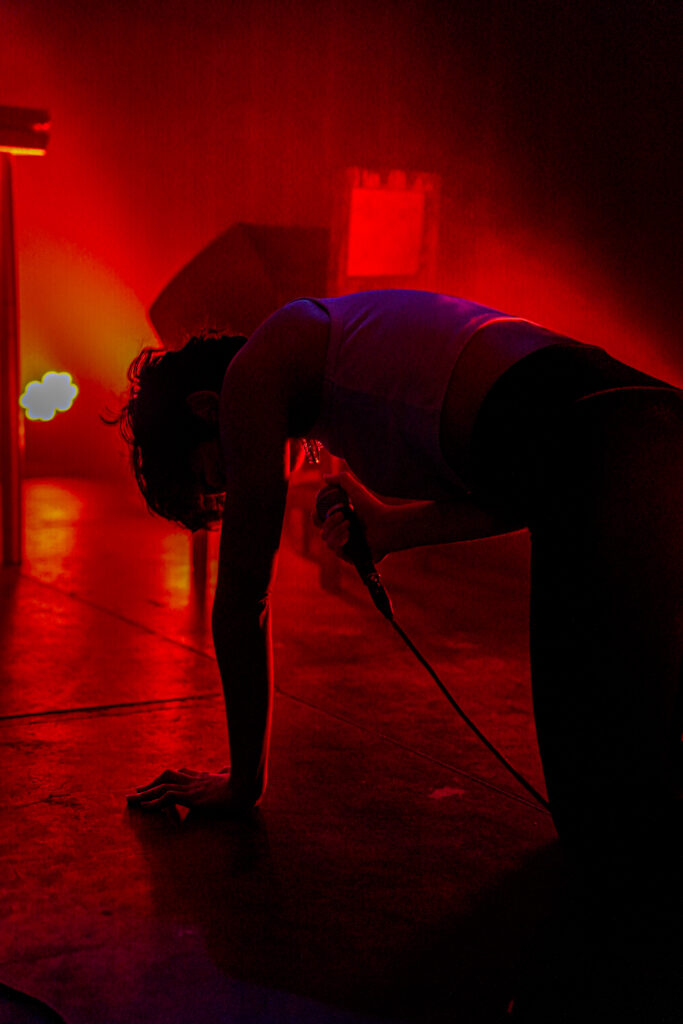
Sinclair, I had the opportunity to discover your work as a producer when you sent me two years ago a track called « État Des Lieux » inspired by bass music and breakbeat, for the second militant album of our collective QSS (Quarantine Sonic Squad) in support of the BAAM (Bureau d’Accueil et d’Accompagnement des Migrant-es). You are also the author of a first solo EP called « Luxury », with a broken beat and electronica-focused sound, released in 2018 or tunes on compilations for the Marseille-based label Omakase in a vein that could be stamped as IDM. You are also a sound designer and editor for different brands and institutions. How did you come to collaborate with Vanda in CainوMuchi, and how do you perceive your approach as a composer and live artist in this duo?
Sinclair: Ah « Luxury » this one takes well back (laughs)! It was self-produced, I wrote it and composed it in one night only. But if you want to know everything, it’s a musical approach that corresponds to a period in my life with which I don’t necessarily feel in sync, on the artistic level, even if I don’t deny this project, is quite the contrary. It laid the groundwork for how I produce while nurturing my imagination. This organic IDM touch that you detected can be due to the fact that club culture and dance music are not things that inspired me at first, I was more interested in the Californian beat music of artists like Shlohmo (Friends of Friends) and Lapalux (Brainfeeder / Ninja Tune).
My arrival in Marseille in 2018, the discovery of the local electronic music scene, the evenings of the Metaphore Collective, and my meeting with Vanda, in particular, aroused a desire in me to get closer to this artistic genre that is club music, in a very broad sense, and thus to imagine the Cain project I was telling you about earlier. Even if this momentum towards the club is not necessarily a prerequisite to composing and producing the music that we propose with this duo. Not being a DJ myself, I have little or no tuning reflex driven by the intensities and drops that are predominant in writing dancing music. This can be an asset as a defect, but it allows to have some flexibility in my approach, which owes more to my learning of sound design and electro-acoustic music.
During my studies in Toulon between 2017 and 2018, I created my first project with a Moroccan singer whom Vanda knows by chance for many years, and this is the first time I have felt this strong desire to work in collaboration with artists whose voice is the main instrument.
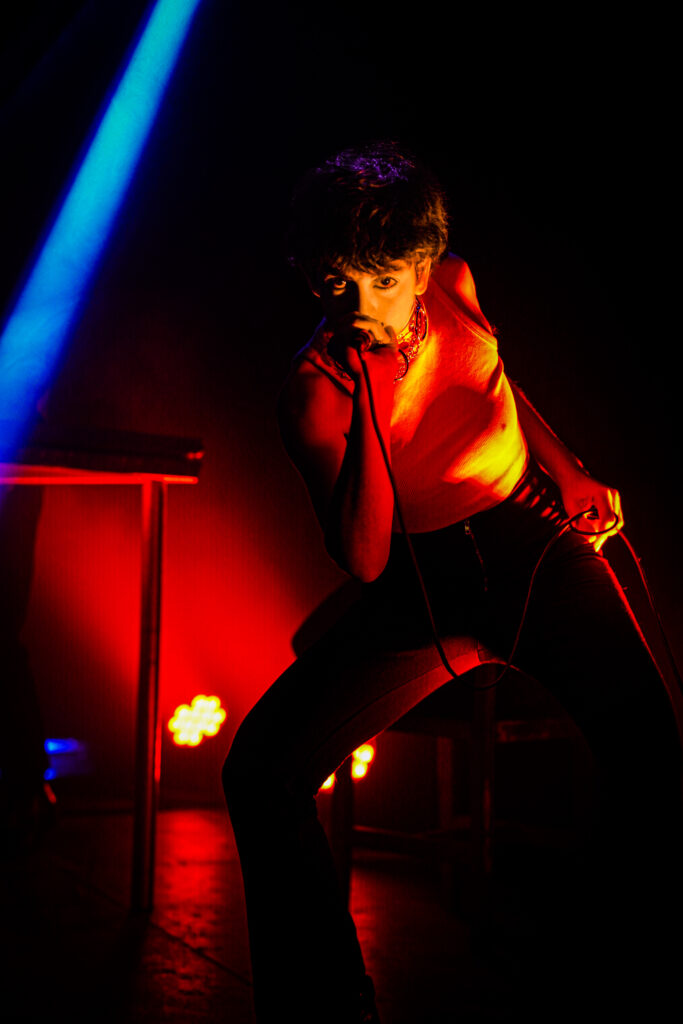
Vanda, you are also a producer and we could hear you collaborate recently on a lot of collective releases with your solo project, as with the Parisians of Attraction Corp or the label Jerry Horny. You also tour as a DJ quite regularly and in many famous places in the Hexagonal club landscape. Can you tell us about this plurality in your musical approach, both as a vocal artist, composer, and performer?
Vanda: Even if I don’t come from club culture either, what I produce solo under my alias Vanda Forte is definitely oriented towards body music, and movement (I prefer these denominations to that of pure and hard « club »). In my DJ sets I try to navigate between a musicality from my acoustic and instrumental background, and things that are closer to hybrid rave energy, and the same goes for the tracks I make like the one called « The Push » for the compilation VENGEANCE LACTOSE VOL.3 published on Jerry Horny in 2022, which is an invitation to dance quite furious.
In my opinion, there is a certain darkness or at least a melancholy assumed in your musical approach. Is this dark approach to sound and text inherent in the body of your project?
Vanda: I think that this supposed « darkness », or at least this dark aspect in our music came in a very natural way, surely linked to our two personalities. But it’s also something we look for aesthetically, because it’s synonymous with a certain artistic depth, at least in my eyes. I would say it’s more about an « emo » aesthetic that can be the result of spending our teenage years listening to rather dark and intriguing things. Most of my first texts questioned rather obscure subjects such as toxic relationships and sentimental rupture. And I realize today that there is a possible identification of the public with this melancholy that works in an almost therapeutic way.
From a listener’s point of view, and despite the obvious impulses of your lives towards club energy, you still oscillate between a song format, although unconventional in its form, and ambient landscapes that counteract calls to hedonism without discontinuity inherent to many electronic musical performances. Is this tensioning of the live format necessary in your sonic and vibrational approach?
Vanda: We can actually talk about a format of songs that does not follow the traditional codes because we do not follow this verse/chorus/bridge in our way of writing the music… It is rather vaporous and we do not want to stick to a certain tradition of popular music that relies almost entirely on this way of doing things.
Sinclair: In the context of a « continuous » live show written for clubs, you are always forced to patch things up permanently, to assemble parts between them. We take the position to think of our show as a succession of pictures with a temporality specific to each of them, which allows us to deploy different energies at several moments of the performance. And as you were told earlier, we need this tension to capture the audience’s attention over a long period of time, when they will not want to get tired or to be caught only in a movement that calls for dance, but also for reflection and appreciation of images.
To go beyond the release of this new EP and your next concert dates, I imagine that you are already thinking about the continuity of your musical work as a duo. If this is the case, can you give us some clues as to what to expect for a future project under the plural identity of Cain و Muchi?
Vanda: We have this shared desire to continue developing our work as a duo in its relationship to the image, also because we both come from an audiovisual artistic background, which leads us to think of a film project whose soundtrack would also be written by us.
Sinclair: For the next months, we are preparing to integrate a residency program at the GMEM in Marseille, which is a national center for musical creation, a sort of the Phocaean equivalent of the IRCAM.
Vanda: When we both studied acoustic creation and musicology during our Master degree, we had some classes that took place there. The director of the center invited us to come and do this residency as part of Babel XP showcase. It is therefore a great pleasure for us to return to this beautiful place where our first duo sound experiments were born! So we will focus on developing an even more advanced live on the sonic level, because we will be entitled to top-notch logistic support, with cutting-edge equipment and teams to follow us daily, we can’t wait!
Sinclair: Then, after the residency period, there will be a presentation of the work that will be produced at GMEM.
Vanda: As for our next live dates, we would very much like to work with VJs and a dedicated sound engineer, who could help us adapt our performance in each of the places where we will perform. We also have some EPs projects currently being validated… lots of things that will happen quickly!
